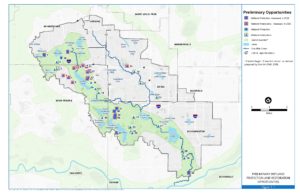Wetland Assessment Report
 The wetlands in the Nine Mile Creek watershed are an important asset. Wetlands provide important functions including plant diversity and habitat for amphibians, fish and other wildlife. Wetlands also provide important benefits such as water quality improvement, flood protection, shoreline erosion control, ground water protection, and carbon sequestration. Additionally, wetlands provide opportunities for wildlife viewing, recreation, education, and cultural resources.
The wetlands in the Nine Mile Creek watershed are an important asset. Wetlands provide important functions including plant diversity and habitat for amphibians, fish and other wildlife. Wetlands also provide important benefits such as water quality improvement, flood protection, shoreline erosion control, ground water protection, and carbon sequestration. Additionally, wetlands provide opportunities for wildlife viewing, recreation, education, and cultural resources.
Why should we inventory wetlands?
During development of the Nine Mile Creek Watershed District (NMCWD) 2017 Water Management Plan, the NMCWD Board of Managers, local cities, and other stakeholders identified wetland protection as an important issue. The District’s Water Management Plan also identifies protecting and restoring high-quality wetlands within the watershed as one of the primary wetland management objectives.
Thus, the NMCWD directed Barr Engineering to conduct a study to identify high quality wetlands within the District. This study will help staff and managers understand the functions and values of these wetlands, as well as identifying specific wetland protection and restoration opportunities.
Barr engineers and staff presented the report to the NMCWD Board of Managers at their board meeting on February 17th, 2021.
Read the full Wetland Assessment Report (PDF)
What did the study find?
Based on the National Wetlands Inventory (NWI), there are approximately 3,968 acres of wetland in the Nine Mile Creek watershed; however, the NWI includes lakes in this total. To narrow it further, Barr engineers used GIS software to analyze these areas. Based on this analysis, they identified 40 specific opportunities for protection and restoration. They then selected 21 sites to visit in the field. Many of these 21 sites were identified as potential high-quality wetlands with unique or rare native wetland community types. Of the 21 site assessments conducted, nine of the wetlands were evaluated as high priority wetland protection opportunities (Section 3.3.3, Results).
Next steps
The District is working with SRF and Applied Ecological Services (a consultant team) to further refine strategies for protecting four high-quality wetlands selected through the 2021 report. In addition, the consultants are examining feasibility for implementing projects at these four wetlands.
To learn more, read the full Wetland Assessment Report (PDF)
